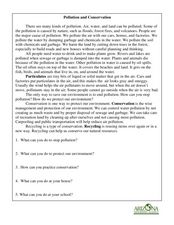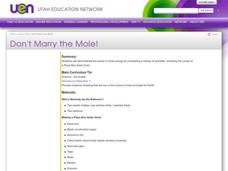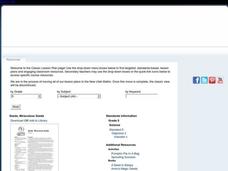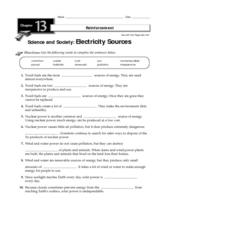Curated OER
What does AG have to do with me?
Students practice alphabetizing while categorizing sources of basic agricultural products. They discuss agricultrual products, discover where they are grown and draw a simple agricultural scene on poster board.
Curated OER
Adaptations To the Environment
Students design and construct an imaginary animal that is perfectly adapted to a particular type of biome. They give the animal a scientific name, place it in a phylum and write descriptions about its behavior, reproduction, foraging,...
Curated OER
Alaska's Physical Systems and History
Middle schoolers read about Alaska's physical systems and determine how Alaska's physical makeup has impacted its history. They create timelines of their particular physical system.
Curated OER
Pollution and Conservation
In this pollution and conservation worksheet, students read a passage on pollution and conservation, and answer short answer, multiple choice, and vocabulary matching questions. Students complete 27 questions.
Curated OER
Scales, Scutes, and Skins
Students identify the various adaptations of reptiles and amphibians. After distinguishing between reptiles and amphibians, students discuss the ways in which their adaptations aid in their survival. They participate in a hands on...
Curated OER
Don't Marry the Mole!
Third graders demonstrate the power of solar energy by completing a variety of activities, including the creation of a Pizza Box Solar Oven.
Curated OER
Frogs
Young learners are more motivated to practice skills when they are motivated. This reading passage about frogs provides a quick and easy way for students to practice comprehension and vocabulary skills by answering the 10 questions.
Curated OER
Agriculture is a Cycle
What do a bicycle and the life cycle have in common? Cover this and more with the series of cross-curricular activities included in this plan. Learners do everything from making bracelets that represent the life cycle to checking out the...
Curated OER
Verterbrate Classification
Students are introduced to the broad categories of vertebrates including fish, amphibians, reptiles, birds and mammals. They identify the characteristics of each group and then view slideshows and video of example species.
Curated OER
Seeds, Miraculous Seeds
Students investigate the growth of seeds. In this agricultural activity, students dissect a bean and corn seed and identify the parts of the seed. Students observe the development of a pinto bean seed and record observations on the...
Curated OER
Life Cycles
Using computers, Students work in small groups and progress through the roles of Explorer, Researcher, Designer, and Evaluator as they study the life cycle of plants, insects, butterflies and frogs.
Curated OER
"Julie of the Wolves"
Fifth graders research life in Alaska and compare life there to their lives in this lesson. They read "Julie of the Wolves." They research through the novel and other reference books facts about the Alaskan climate and geography. They...
Curated OER
Camouflage, Protection, & Adaptations—Who am I?
Students explore ocean animal adaptations. For this animal adaptations lesson, students examine how different ocean animals use adaptations other than camouflage to protect themselves.
Curated OER
Biogeography
Third graders listen to a teacher led lecture about species living in different parts of the world. They study how the species spread to different parts of the world and examine the concept of dispersal. As a class, 3rd graders...
Curated OER
Data Analysis: bird habitats in rice farms
Fifth graders make a graph and write an essay to interpret the data of birds that take advantage of habitats near rice farms. In this data lesson plan, 5th graders calculate the information given to them and interpret it in an essay form.
Curated OER
Radical Reptiles
In this reptiles instructional activity, students read about reptiles and then answer 10 questions about what they just learned. The answers are on the last page.
Curated OER
Native Versus Exotic
Students investigate the presence of exotic and natural species in the ecosystem. They define the differences between exotic and native while looking at one specific ecosystem in Maryland. They write how the exotic species are considered...
Curated OER
Amazing Amphibians- Reading Comprehension
In this amazing amphibians instructional activity, students read a one page essay about the characteristics of amphibians. They answer 10 true and false questions based on the reading.
Curated OER
Article Review
For this article review worksheet, students are given a passage they must correct for errors. Students correct mistakes in the articles usage in the passage provided.
Curated OER
What's a Swamp Good For?
Students identify the function and value of wetlands. For this lesson on appreciating wetlands, students explain how different household items can represent different aspects of the wetlands.
Curated OER
Galapagos Adaptations
Students examine photographs of closely related species found in the Gal??pagos environment, observe differences and similarities between species, and form hypotheses about species differences and the relationship to the environment of...
Curated OER
Electricity Sources
In this electricity learning exercise, students review the different types of energy sources including fossil fuels, solar, wind, and nuclear energy. This learning exercise has 10 fill in the blank questions.
Curated OER
Knowledge Quiz
In this oceans quiz worksheet, students complete a 10 question multiple choice quiz covering a variety of concepts related to the ocean.
Curated OER
What If We Run Out?
Students explore the consequences of shrinking habitats and the human impact on wildlife populations. They participate in a game to study the consequences and describe the preservation of animal habitats.

























